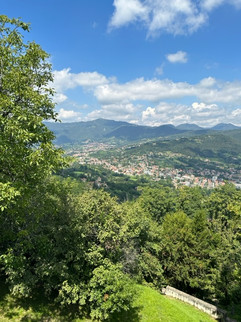Bergamo
- Maria Scuor
- Dec 2, 2023
- 8 min read
Italiano in ogni sezione
When our friends Dennis, Lorraine, Joe and Sharon spent some time with us in Arona, we took a day trip to Bergamo in the Lombardy region, on a day Gianni didn’t have therapy. Just over 100km away from Arona it was a short drive on the freeway. However, getting off the freeway was a little more challenging because due to road work the two vehicles got separated. Thankfully for technology, a pin of location, got us back on track.
Quando i nostri amici Dennis, Lorraine, Joe e Sharon hanno trascorso un po' di tempo con noi ad Arona, abbiamo fatto una gita a Bergamo in Lombardia, in un giorno in cui Gianni non ha fatto terapia. A poco più di 100 km da Arona è stato un breve tragitto in autostrada. Tuttavia, uscire dall'autostrada è stato un po' più impegnativo perché a causa di lavori stradali i due veicoli si sono separati. Fortunatamente per la tecnologia, un pin di posizione ci ha rimesso in via.
Bergamo is composed of an old walled core, known as Città Alta (High City) which is nestled in the hills of Bergamo natural park. The lower more modern city below is called Città Bassa. The population of Bergamo is around 120,000 people.
We found parking close to the base of Città Alta but first we stopped for a quick coffee/lunch. Luckily there are lots of restaurants to choose from. We took a bus up to the Città Alta and spent time exploring the fortified city and having a gelato.
The Venetian walls that fortify the city are over 6 km long which were built starting in 1561 by the Republic of Venice, in order to face enemies’ attacks. Luckily history was good to them because they never underwent any siege and are almost intact today. The walls required over 250 buildings to be removed, including 8 religious properties. The walls became a UNESCO (United Nations Educations, Scientific and Cultural Organization) World Heritage Site on July 9, 2017.
Here are photos of the Fortified City – Ecco foto della città fortificata
Bergamo è composta da un antico nucleo murato, noto come Città Alta, che è immerso nelle colline del parco naturale bergamasco. La città più bassa e moderna sottostante si chiama Città Bassa. La popolazione bergamasca è di circa 120.000 persone.
Abbiamo trovato parcheggio vicino alla base di Città Alta, ma prima ci siamo fermati per un caffè/pranzo veloce. Per fortuna ci sono molti ristoranti tra cui scegliere. Abbiamo preso un autobus fino a Città Alta e abbiamo trascorso del tempo esplorando la città fortificata e ci siamo goduti un gelato.
Le mura veneziane che fortificano la città sono lunghe oltre 6 km e furono costruite a partire dal 1561 dalla Repubblica di Venezia, per fronteggiare gli attacchi nemici. Per fortuna la storia è stata buona con loro perché non hanno mai subito alcun assedio e oggi sono quasi intatti. Le mura hanno richiesto la rimozione di oltre 250 edifici, tra cui 8 proprietà religiose. Le mura sono diventate Patrimonio dell'Umanità dell'UNESCO (Organizzazione delle Nazioni Unite per l'Educazione, la Scienza e la Cultura) il 9 luglio 2017.
Once we finished our gelato, we bought funicular railway tickets to go to the top of Città Alta. A funicular is a cable railway system that connects points along a railway track that is laid on a steep slope. This type of system has two cars/trains permanently attached at opposite ends of cable, which is looped over a pulley at the upper end of the track. This results in two carriages move synchronously: as one ascends, the other descends at equal speed.
Una volta finito il nostro gelato, abbiamo comprato i biglietti della funicolare per andare in cima a Città Alta. Una funicolare è un sistema di funivie che collega i punti lungo un binario ferroviario che si trova su un ripido pendio. Questo tipo di sistema ha due vagoni/treni fissati in modo permanente alle estremità opposte del cavo, che è avvolto su una puleggia all'estremità superiore del binario. Il risultato è che due carrelli si muovono in modo sincrono: mentre uno sale, l'altro scende alla stessa velocità.
We explored the beautiful park area and grounds. Here are photos of the funicular and the incredible scenery from the top as well as our time with our friends. Abbiamo esplorato la bellissima area del parco e i giardini. Ecco le foto della funicolare e dell'incredibile scenario dalla cima e tempo con i nostri amici.
Once back into Città Alta, we walked the interconnecting streets and stopped in St. Agatha Church (Chiesa Sant’Agata nel Carmine). There is documentation that the original church dates back to 908 and was rebuilt in 1357 by the Humiliati order coming from Alessandria, in Piedmont. In 1453 it was consecrated for the first time by bishop Giovanni Barozzi.
In the 1700s the church went through more expansions and in 1851 it was renovated into the Baroque Style with the construction of the façade designed by Alessandro Fiorani in 1883. Due to major water damage in 2012, the church had to be restored to what it is now.
Una volta tornati in Città Alta, abbiamo camminato le strade comunicanti e ci siamo fermati nella Chiesa di Sant'Agata nel Carmine. È documentato che la chiesa originaria risale al 908 e fu ricostruita nel 1357 dall'ordine degli Umiliati provenienti da Alessandria, in Piemonte. Nel 1453 fu consacrata per la prima volta dal vescovo Giovanni Barozzi.
Nel 1700 la chiesa subì ulteriori ampliamenti e nel 1851 fu ristrutturata in stile barocco con la costruzione della facciata progettata da Alessandro Fiorani nel 1883. A causa dei gravi danni causati dall'acqua nel 2012, la chiesa ha dovuto essere restaurata e riportata a quello che è ora.
Here are some photos of the church – Ecco alcune foto della chiesa
Here are photos of some of the streets and scenery along the way - Ecco le foto di alcune strade e paesaggi lungo il percorso
When we walk through the town we get to Piazza Vecchia, where we find the large white Palazzo Nuovo (New Palace). It houses the Angelo Mai civic library, which is the main historical conservation institution of the Bergamo library circuit. The piazza also hosts:
Piazza della Ragione (Palace of Reason) which dates back to the 12th century and houses the Fresco Museum
Torre Civica (Civic Tower) built between 11-12th centuries was originally used to house the Suardi family, one of the most powerful families of that time. Over the centuries it was a hospice and a prison. By the 1600s bells were installed and in 1656 it was blessed and renamed Campanone by the inhabitants. It would ring 100 times at ten every evening to indicate the curfew that the four gates around the city were closing. This custom still exists today to keep the memory of the past
Palazzo del Podestà (Podesta’s Palace) which was also built in the 12th century and in 2012 the interactive historical museum of the Venetian age “The Museum of the Cinquecento” was set up. The interactive rooms transport you back to the Middle Ages, through a journey that leads you from Venice to Bergamo
In the center of the square is the Fontana Contrarini (Contrarini Fountain) which owes its name to Alvise Contrarini, the mayor of the Republic of Venice who gave it to the citizens in 1780
Passeggiando per la città arriviamo in Piazza Vecchia, dove troviamo il grande Palazzo Nuovo. Ospita la biblioteca civica Angelo Mai, che è la principale istituzione di conservazione storica del circuito bibliotecario bergamasco. La piazza ospita anche:
Piazza della Ragione che risale al XII secolo e ospita il Museo dell'Affresco
La Torre Civica, costruita tra l'XI e il XII secolo, era originariamente utilizzata per ospitare la famiglia Suardi, una delle famiglie più potenti dell'epoca. Nel corso dei secoli è stato un ospizio e una prigione. Nel 1600 furono installate le campane e nel 1656 fu benedetta e ribattezzata Campanone dagli abitanti. Suonava 100 volte alle dieci ogni sera per indicare il coprifuoco che le quattro porte intorno alla città stavano chiudendo. Questa usanza esiste ancora oggi per mantenere la memoria del passato
Palazzo del Podestà, anch'esso costruito nel XII secolo, e nel 2012 è stato allestito il museo storico interattivo di età veneziana "Il Museo del Cinquecento". Le sale interattive ti trasportano indietro nel Medioevo, attraverso un viaggio che ti porta da Venezia a Bergamo
Al centro della piazza si trova la Fontana Contrarini che deve il suo nome ad Alvise Contrarini, il sindaco della Repubblica di Venezia che la donò ai cittadini nel 1780
Here are photos of Piazza Vecchia and the surrounding buildings - Ecco le foto di Piazza Vecchia e degli edifici circostanti
Just past Piazza Vecchia there is Piazza del Duomo and here there are two Catholic Institutions. The first you see straight in front as you enter the piazza is Basilica di Santa Maria Maggiore, built in the second half of the 12th century. The exterior retains it’s Romanesque-Lombard style while inside it was renovated to Baroque style between the 1600 – 1700 century. History documents that it was built to comply with a vow made in 1133 to the Madonna (Mother Mary) by the people of Bergamo to protect them from the plague hitting northern Italy. We didn’t go into the Basilica as it had a long line up.
To the right of the Basilica is the Duomo di Bergamo (Bergamo Cathedral), dedicated to Saint Alexander who is the patron saint of Bergamo. The original church dedicated to Saint Alexander, which was the oldest, had to be demolished in 1561 to make way for the Venetian walls. This locations has history verifying the first church dedicated to Saint Vincent dates back to 774 and in 1561 the body of Saint Alexander was moved to Saint Vincent church, allowing two devotions and canons of different chapters to coexist. In 1704 the Basilica was dedicated to Saint Alexander and over the centuries went through many renovations. The dome was completed in 1879 by Angelo Bonicelli. We were able to visit inside this beautiful Cathedral.
Appena superata Piazza Vecchia c'è Piazza del Duomo e qui si trovano due Istituzioni Cattoliche. La prima che si vede di fronte entrando nella piazza è la Basilica di Santa Maria Maggiore, costruita nella seconda metà del XII secolo. L'esterno conserva il suo stile romanico-lombardo mentre all'interno è stato ristrutturato in stile barocco tra il 1600 e il 1700. La storia documenta che fu costruita per ottemperare ad un voto fatto nel 1133 alla Madonna dai bergamaschi per proteggerli dalla peste che colpì il nord Italia. Non siamo entrati nella Basilica perché c'era una lunga fila.
Alla destra della Basilica si trova il Duomo di Bergamo, dedicato a Sant'Alessandro, patrono di Bergamo. L'originaria chiesa dedicata a Sant'Alessandro, che era la più antica, era demolita nel 1561 per far posto alle mura veneziane. La storia di questo luogo attesta che la prima chiesa dedicata a San Vincenzo risale al 774 e nel 1561 il corpo di Sant'Alessandro fu traslato nella chiesa di San Vincenzo, permettendo la coesistenza di due devozioni e canonici di capitoli diversi. Nel 1704 la Basilica fu dedicata a Sant'Alessandro e nel corso dei secoli subì numerosi rifacimenti. La cupola fu completata nel 1879 da Angelo Bonicelli. Abbiamo potuto visitare l'interno di questa bellissima Cattedrale.
Here are photos of Piazza del Duomo - Ecco foto di Piazza del Duomo
We ended our tour of this beautiful city sitting on a veranda cheering up our friendship with prosecco in hand. What a beautiful day.
Abbiamo terminato il nostro tour di questa bellissima città seduti su una veranda a rallegrare la nostra amicizia con il prosecco in mano. Che bella giornata.































































































































































Comments